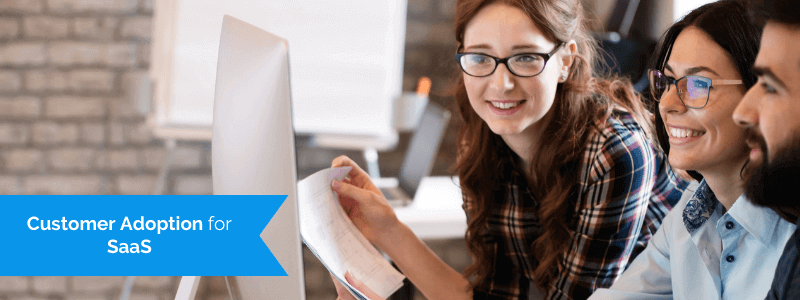When you start a SaaS company, one of your leading goals is to have customers who will successfully use your product.
These days, the best products aren’t the ones with the best features, but the ones with a good customer adoption strategy.
Convincing people to see value in your product is a continuous process. It doesn’t stop after initial onboarding and the first Aha! Moment.
You should aim for a great experience, but you should also replicate it at every opportunity.
What can you do to help users become customers and adopt your product for a long time?
There is no perfect solution, but there are several things you can start doing today that can help your adoption rates significantly.
Jump to section:
What Is Customer Adoption?
Why Is Customer Adoption Important?
Tips for Improving Customer Adoption
What Is Customer Adoption?
Customer adoption is a process in which a new user starts working with your product and reaches activation.
The first few interactions with a product are essential for the customer to learn how your product works. If done correctly, this can prevent churn.
The goal is to use activation for a long-term commitment.
Appcues discovered that a 25% increase in activation resulted in a 34% higher MRR in the first year.
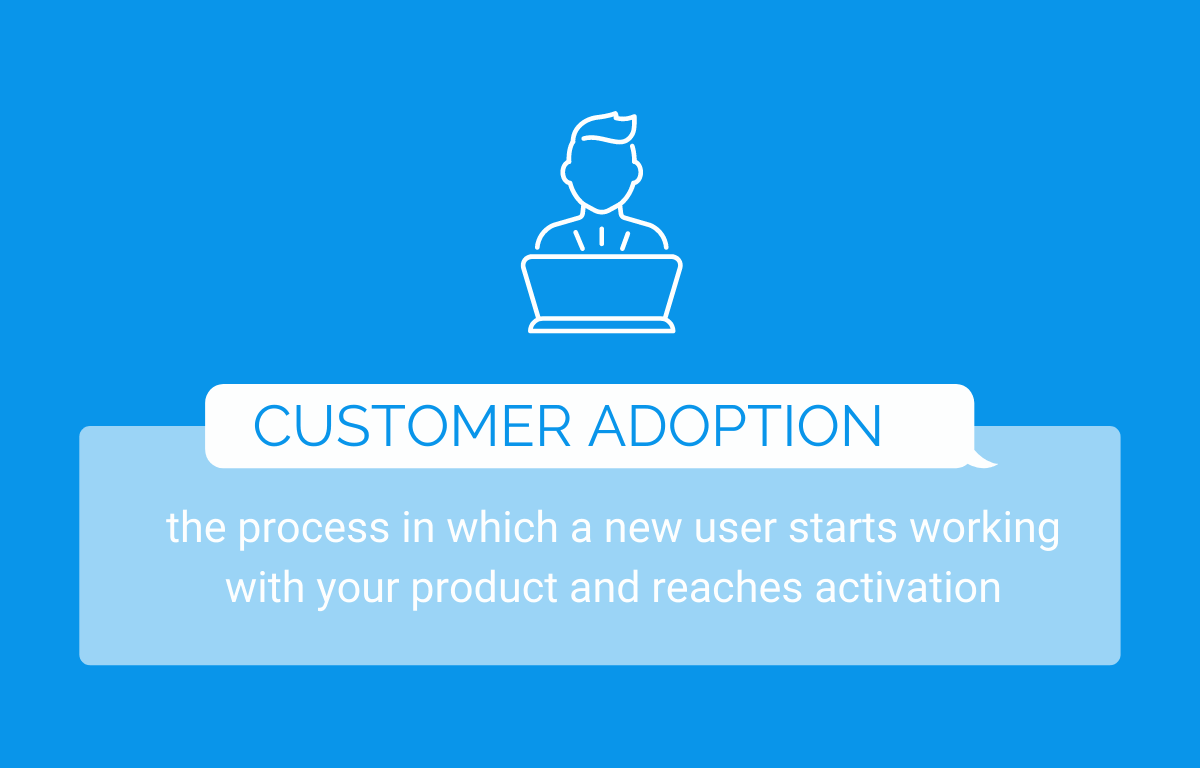
Customer adoption can occur at different stages during user onboarding, but it’s best if it happens as soon as possible.
The faster your users see value in your product, the easier it will be to convert and retain them.
Customer adoption is vital for a company’s long-term growth and success.
Why Is Customer Adoption Important?
Customer adoption is the first step in creating a loyal customer.
A successful customer adoption process will ensure that customers continue to get value from your product as long as they use it. In addition, if you implement the right strategy, you can improve your conversion rates and reduce churn.
A good customer adoption process can also help grow existing accounts.
This significantly impacts your CAC (customer acquisition cost) and LTV (customer lifetime value).
As we all know, acquiring new customers is more costly than selling to existing customers.
When you’re planning your customer adoption strategy, your end goal should be to keep your customers engaged and satisfied with your product.
SaaS customers are different from others because they pay for your service regularly, which means you’re continuously assessed for value.
The more you maintain that perceived value, the higher your retention rates will be.
Customer adoption focuses on how users perceive the value they get from your product, but it is also a web of different factors (marketing, product, customer success, etc.) that influence each other.
In the end, everything you do in your product and around it should be aimed at getting your customers to integrate your product into their lifestyle.
Tips for Improving Customer Adoption
A great customer adoption strategy improves the overall state of your business.
Here is how to implement it.
Determine Your Activation Criteria
Activation criteria will help you determine where your customers find value.
You need to create a specific set of tasks you want your customers to do so they get value from your product. These tasks depend entirely on your product and its complexity.
For some, it might be sending ten invoices, five emails, or three newsletters. Whatever your bar for successful activation is, it should convince your customers that they come back.
Your criteria shouldn’t be a general wishlist for your customers—you need to choose specific tasks. This will also help you determine pain points and possible reasons for churn.
At first, it’s helpful to guide them to the initial criteria and show them how to do the tasks in question, but after that, it’s more beneficial to let them find their own way around.
Have a help section always visible and reachable, but after the first set of tasks to reach activation, leave them to adopt your product naturally.
Activation criteria are your benchmark for determining the initial success of your customer adoption strategy.
Understand Why Customers Use Your Product
Understanding the users’ motivations for using your product can help you improve your customer adoption strategy.
It’s time to take a few steps back and analyze the market again.
Before you fully launched your product as a startup, you had to test the product/market fit. Now you have to do it again, but with more precise criteria in mind.
Your sales team can help you determine more nuances in the real-life problems of your potential customers. They are the ones who directly communicate with them, so they understand the users’ motivations and goals in adopting new products.
You must look into your leads and current customer base simultaneously.
Your existing users can tell you more about the product value and their customer profile, and you can use that information to attract similar customer profiles.
Look at common trends in how your customers use your product and how they talk about it.
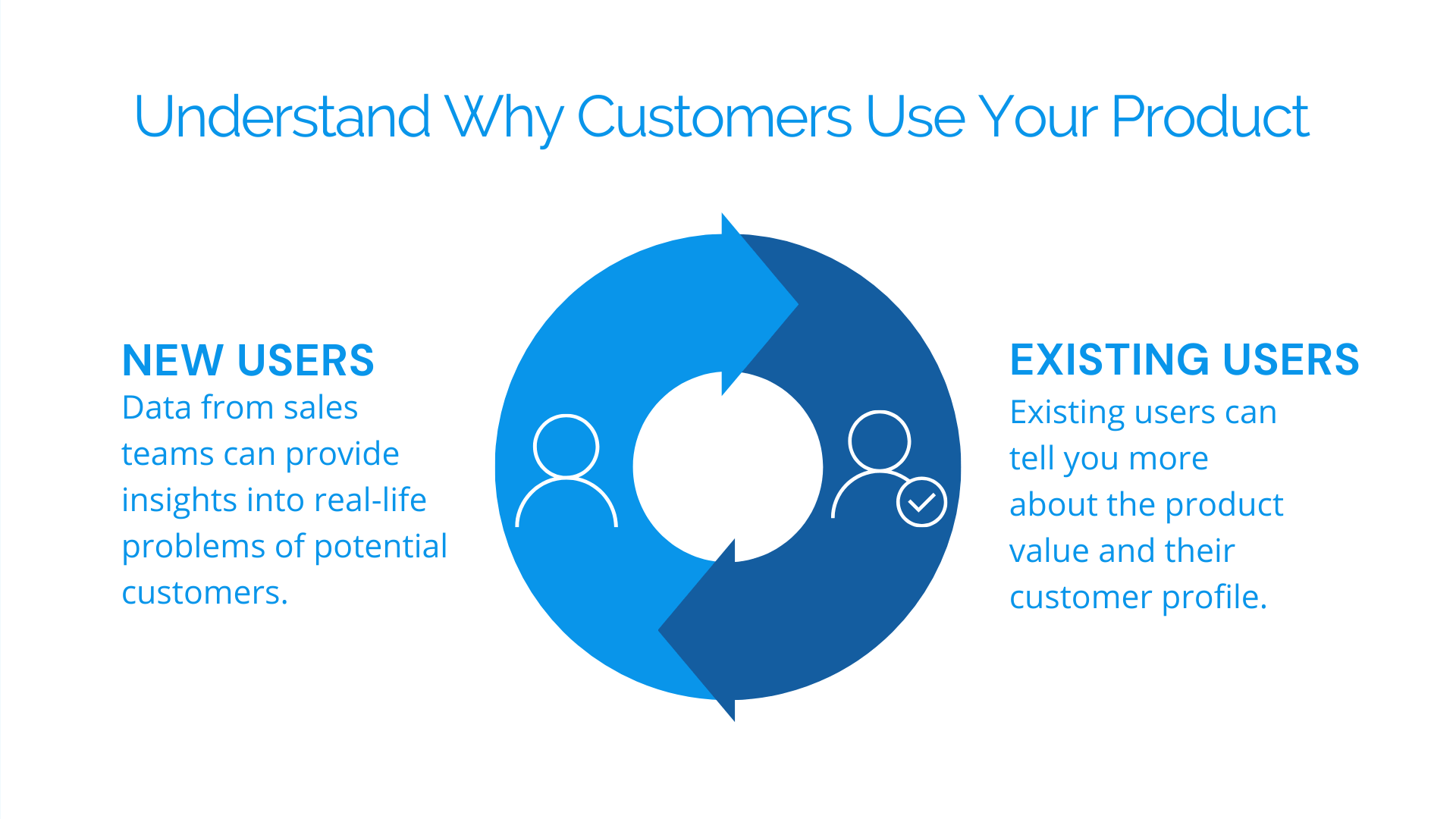
Then, you need to re-establish the product/market fit, so users continue seeing value in your product. You can also find new potential customers to target.
Understanding how your customers perceive the value of your product is essential because their vision might differ from your own.
Your customers are the ones that use it, and you should use this information to shape their onboarding experience.
Improving user adoption starts with understanding why they use your product in the first place.
Offer a Trial Period
Trial periods help attract more customers.
Show potential customers what your product can do for them by offering them free trials. They’re widely used in Saas, mostly as an acquisition and conversion strategy.
Your trial period should have all the necessary and helpful features available, so your customers reach activation quickly.
Then, once you take certain features away after their trial ends, they will be more likely to buy a premium plan to continue using them.
The optimal trial period lasts between two weeks and a month. That’s your sweet spot to intensify your adoption strategy and keep them engaged to reach activation.
Use that time to build a healthy foundation for your sales team to convert your free trial users to paying customers.
Attract your customers’ attention with free trials and use them for successful conversion.
Create an Onboarding Team
Improve your onboarding process to boost your customer adoption strategy.
Onboarding is the first step towards successful customer adoption, and everything you put in there can affect their overall experience.
During onboarding, it’s vital to educate your customers about your product. To do that effectively, you should avoid throwing as much information as you can at them.
For a deeper understanding of your product, use different tools and methods to familiarize them with your product features.
Do it in small digestible chunks and build on their initial interest in time.
Once they get more comfortable using your features, they’ll want to achieve more, and you should meet their demands halfway. As their needs grow, so should your product.
Your onboarding process needs different elements:
- Landing pages
- Video tutorials
- Support chats
- Webinars
- In-app messages
- Emails
These are just a few of the things you need for a great onboarding experience.
The trouble is that each of these elements may be delegated to different departments to embed into your final product.
As your product grows, it’s easy to get disconnected from different departments in your company and let each of them do their own thing.
But onboarding is a holistic journey for your customers, and to create a good experience, all of your departments should work as a unit.
One great solution is to have a dedicated team member in each department tasked with inter-departmental communication.
That way, everyone will be up to date with everything related to onboarding tasks.
Create an onboarding team for a successful onboarding experience that will retain your customers.
Use a Digital Adoption Platform
Digital Adoption Platforms will help you simplify your learning processes to reach activation.
We’ve outlined the importance of good onboarding for customer adoption, and digital adoption platforms can help you create it.
They are SaaS solutions for simplifying the adoption of new processes and technology.
They collect data and function as an automated onboarding tool for a better learning experience for your customers.
In addition, they make the entire onboarding and learning process very intuitive.
DAPs are widely adopted because they are a cost-effective way to combat the negative consequences of a poor onboarding process.
Some other benefits to using a DAP are:
- Reduced customer support costs
- Reduced employee training and improved productivity
- Standardized process with the ability to scale
- Saving time on repetitive tasks with automation
Another great thing about standardized solutions is that they enable you to collect more clear data while keeping the customers’ onboarding experience streamlined.
DAPs are designed to improve customer experience. They provide valuable information right when the customer needs it by tracking their behavior.
The costs of training and education are low, and automation improves the in-app process for greater customer satisfaction.
Use Digital Adoption Platforms to take care of your onboarding and to accelerate customer adoption.
Use Contextual Content
Intuitive interface and getting the right information at the right time impact customer adoption.
With each new feature, you have to teach your customers how to use it, so onboarding is a never-ending process.
Even after mastering everything else in your product, once you introduce new features, they will have to go back to taking baby steps in order to get familiar with your product.
People love simplicity when learning about new things.
Therefore, your UI should be appealing and easy to navigate so your users can quickly start with your app. But you shouldn’t stop at a good UI.
While it’s essential to be clear and straightforward in explaining new features, what you do after that also matters.
You need more than just articles and video tutorials to help your users.
The more resources you have, the better.
Also, the content that accompanies your product should always be high-quality.
When we talk about content, that includes webinars, knowledge bases, video tutorials, and other documentation.
Everything you use to teach your user how to interact with your product needs to be carefully structured.
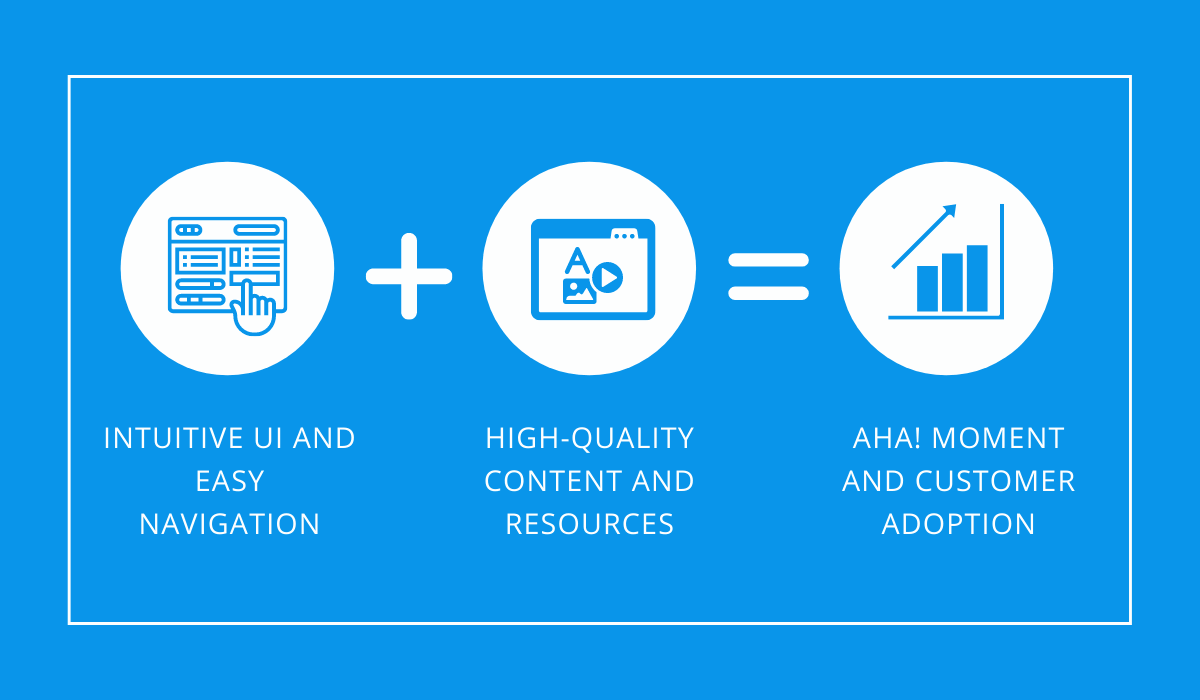
Once you have the best content for your product, think about implementing it into the user’s onboarding process. Again, the best way to learn is to see the feature in context.
If you want to teach them how to send their first newsletter, it’s best if they’re interacting with the feature in real-time. In that way, they’re learning by doing and have readily available support.
Getting the right information at the right time helps users reach their Aha! Moments and improve customer adoption.
Provide Customer Support and Training
Customer support is a vital part of the customer adoption process.
Customer adoption includes quick learning about a product but also having support throughout.
Some reports show that only 64% of businesses had an adequate response time to customer’s questions.
So naturally, problems will arise, and how you deal with them will impact your churn and adoption rates.
You can have the best product on the market, but you’ll never grow your business the way you want if you lack in the customer support department.
Offering various channels and keeping track of them is a must. In addition, your response needs to be timely, and you’ll have to give more effort in hiring the right people for your customer support.
The first step in improving customer support is to make it accessible. For example, easy access in-app to having social media and email options is a good way to ensure customer adoption.
Next, look into automating the process of gathering information and finding recurring problems.
Most of your customers will likely have questions about similar things, so making that process easier to manage will be a time-saver for your customer support employees.
And finally, think about providing visual communication.
Sometimes it’s best to explain the solution via video call, as it can speed up resolving problems.
You can offer a more personal approach and create a basis for a customer success strategy.
Customers will experience problems, and how you approach them directly impacts your customer adoption.
Analyze Product Usage
Product usage can tell you more about customer’s in-app behavior and problems they encounter.
Analytics are everything for SaaS.
Having hard data to back your business decisions is a must and the same mindset needs to be applied to your customer adoption process.
Sometimes, customer surveys and feedback can be misleading because customers are unable to articulate how and why they use certain features.
When you use product usage analytics, you can see the specific things they do. This helps development teams prioritize updates on particular features.
Other things you can measure with product usage analytics are:
- Product performance
- Most popular features
- Heavy users
- User’s engagement
- Product stickiness
- Friction points
- Typical user workflow
- Effectiveness of different engagement strategies
- Results of A/B testing
Imagine how many things you can improve when you have all of this data!
First, it helps clarify the most common problems and gives you a clear picture of how effective your onboarding is.
Furthermore, it enables you to identify ‘’at-risk’’ customers, i. e., those who stop using your product as much. Then you can target them and re-engage them.
Identify how your onboarding process sticks with your customers and use it to re-engage inactive users.
Market to Your Current Customers
Increase customer adoption by effectively marketing to your existing customer base.
Everyone knows the cost of acquiring new customers. It’s always too high.
Moreover, just as you need new customers, you need to cater to your current customers as well. Nurturing relationships is the center of your customer success strategy.
It’s easier to engage with customers who already use your product and see value in it. The trick is to spice their experience up with new things.
The first thing you can do is update your product.
Don’t mess with your most popular features unless they need a bit of tweaking to better integrate with the rest of your product. Instead, try focusing on those features your customers have trouble using.
With several strategic improvements, they could make your product more sticky.
Introducing new features is the next thing you should do.
Look into what your customers want and see how you can implement it into your product.
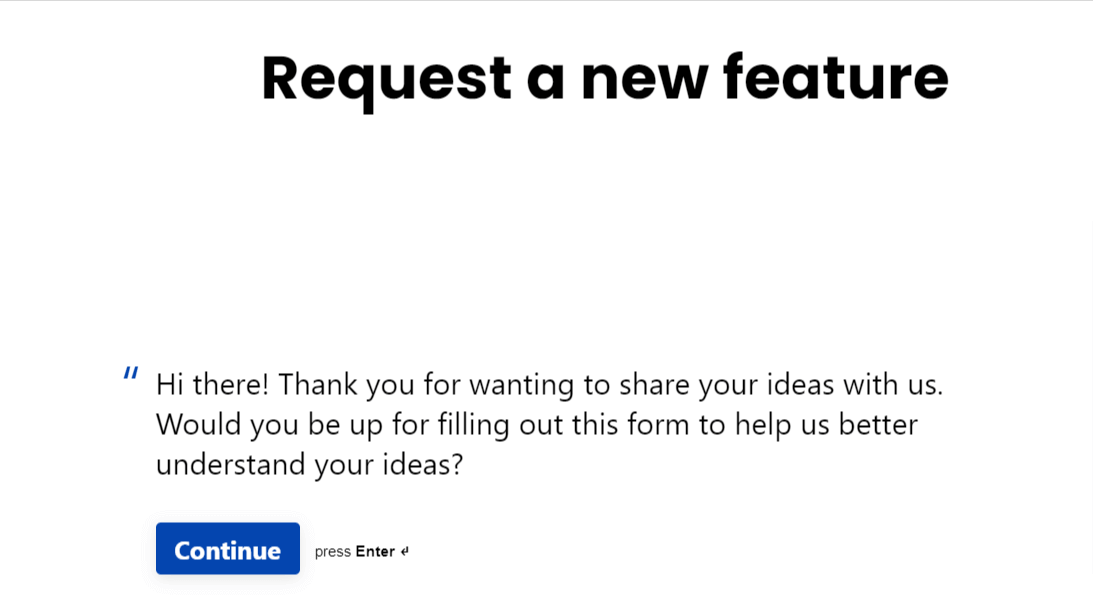
Not all requested features can work, but you can use them for a brainstorming session with your team to develop a good solution.
When you want to re-engage your current customers, you should do everything to keep their minds on your product.
Getting them excited about new features or improving something they struggled with can positively impact user engagement and product adoption.
Increase the value of your product and become customer-centric with a marketing tactic to engage your current customers.
Learn From Feedback
Use customer feedback to improve the customer adoption process.
Even though we’ve said that customers can’t be entirely reliable in providing accurate information, they are helpful in other ways.
While they might not be too technically savvy to understand what each feature does for achieving their goals, they can tell if they’re happy or not.
Sometimes that’s all you need to take appropriate action.
They’ll tell you if your customer support agents were helpful or not; they’ll also inform you if your mobile app is lacking, or anything else they have a problem with.
Talking to them individually is helpful for small customer bases or small startups.
However, once you grow your business, it is necessary to have a clear strategy for acquiring customer feedback.
It’s essential to have a centralized platform to gather all the information regarding customer feedback.
In addition, it’s helpful for your customer support and customer success teams to navigate common problems and individual inquiries.
They can also access a customer’s history of inquiries and help them immediately.
Another thing you should consider is allowing customers to exchange information. They can engage with each other if they encounter similar problems or offer solutions.
Collaborating on tickets can help build a community in your customer base.
Also, you’re enabling transparency which your customers will appreciate, giving you brownie points towards customer adoption.
Creating an effective feedback system can help you gather important information about your customer’s needs and wants.
Create Customer Milestones
Milestones are a great way to track progress towards customer adoption.
Customer success programs need to actively monitor their customer’s progress towards reaching their goals.
It’s not enough to create goals with your customers. You also need some measurable steps and milestones that will help them achieve their plans.
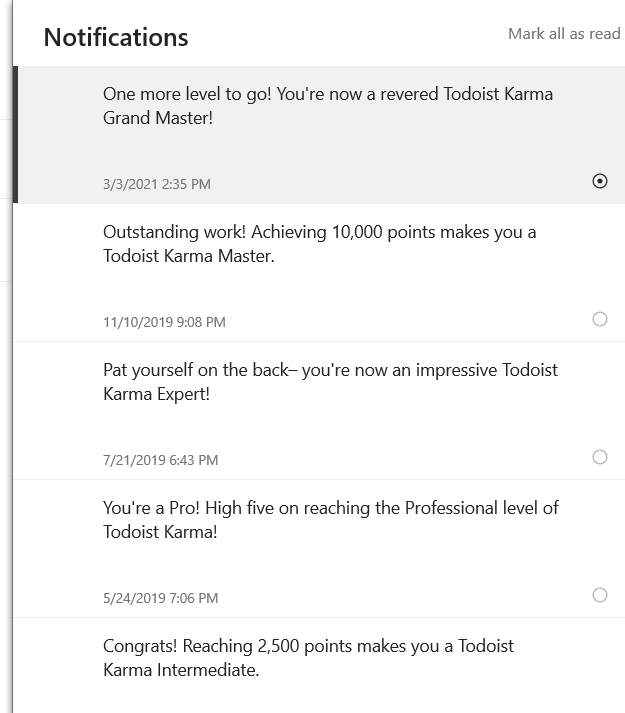
People are often intimidated by setting big goals and usually don’t take steps to achieve them.
If users break their goals into smaller milestones, they eliminate the pressure of getting from point A to point B quickly.
Setting milestones will also ensure they learn about your product step by step, so their product adoption is smoother.
Users can also transition to using more advanced features after they master the basics.
After each milestone, remind them how this helps them towards their overarching goal.
Through milestones, customers reaffirm the value your product provides them, and they are also becoming loyal customers.
Conclusion
Customer adoption is an integral part of a good customer onboarding process.
After you make the effort to understand your customer base and find your activation criteria, everything else will fall into place.
Hook your users into engaging with your product through free trials and make their experience enjoyable by using a digital adoption platform.
While you need to keep your customer’s needs in mind, also ensure that your customer support team effectively uses their time to help your users.
Finally, taking customer feedback and creating milestones can be the cherry on top of your customer adoption strategy.
Be proactive in helping them achieve their goals and create a product they can’t live without.


